As we pass the mid-point of 2021, many herald hybrid remote work as the future. It’s actually just a transition point on a much longer transformation of work in general. Some will be positive changes and some may not. Most people confuse hybrid remote work as a destination for their workforce. It may be more useful to consider it as more than one bridge to other options for remote work.
But first, let’s unpack what hybrid remote work looks like.
Hybrid remote work takes many forms
First, let’s assume we consider only knowledge work in this article. Second, let’s assume the knowledge workers are organised as a team. One of the people that influenced my thinking about teams was Dr. Christopher Avery, an agile leadership expert. When I think about teams, I always keep his definition in mind: “A team is a group of individuals responding successfully to the opportunity presented by a shared responsibility.”
Shared responsibility in a team means that:
- The team needs a shared understanding of the work to be accomplished
- Each team member brings unique skills or knowledge to meet the shared responsibility
- Each team member is aware of the steps to achieve the shared responsibility
- Team members can easily coordinate on tasks to accomplish those steps
- The team has readily available resources
- The team has a shared responsibility for making progress on the work visible
This means I’m not considering work groups where individuals do the same kind of work and don’t collaborate on the work. With this information in mind, I would modify Avery’s perspective to define a hybrid remote team as follows:
Hybrid Remote Team: A group of individuals that are rarely all co-located and can respond successfully to the opportunity presented by a shared responsibility.
In my book co-authored with Johanna Rothman, From Chaos to Successfully Distributed Teams, we identified two basic types of hybrid-remote teams: satellite teams and cluster teams.
This first type of hybrid remote team, the satellite team, consists of most of the team in one location and a few members working in locations without other team members co-located. The satellite team occurs frequently within small to medium organisations and emerges when all team members cannot easily be brought into the office for any number of reasons.
One reason a satellite team forms is when a team member with unique expertise has been hired or relocated to another geography. For example, “we need to hire this contractor who has deep expertise in Salesforce for our project”. The satellite team also develops when a valued team member cannot be in the office for personal reasons (e.g., child care, attending to sick family members, or a spouse found a new job opportunity in another city).
A simple way to remember the satellite team is to think of the work of the remote team member as orbiting the work of the main part of the team.
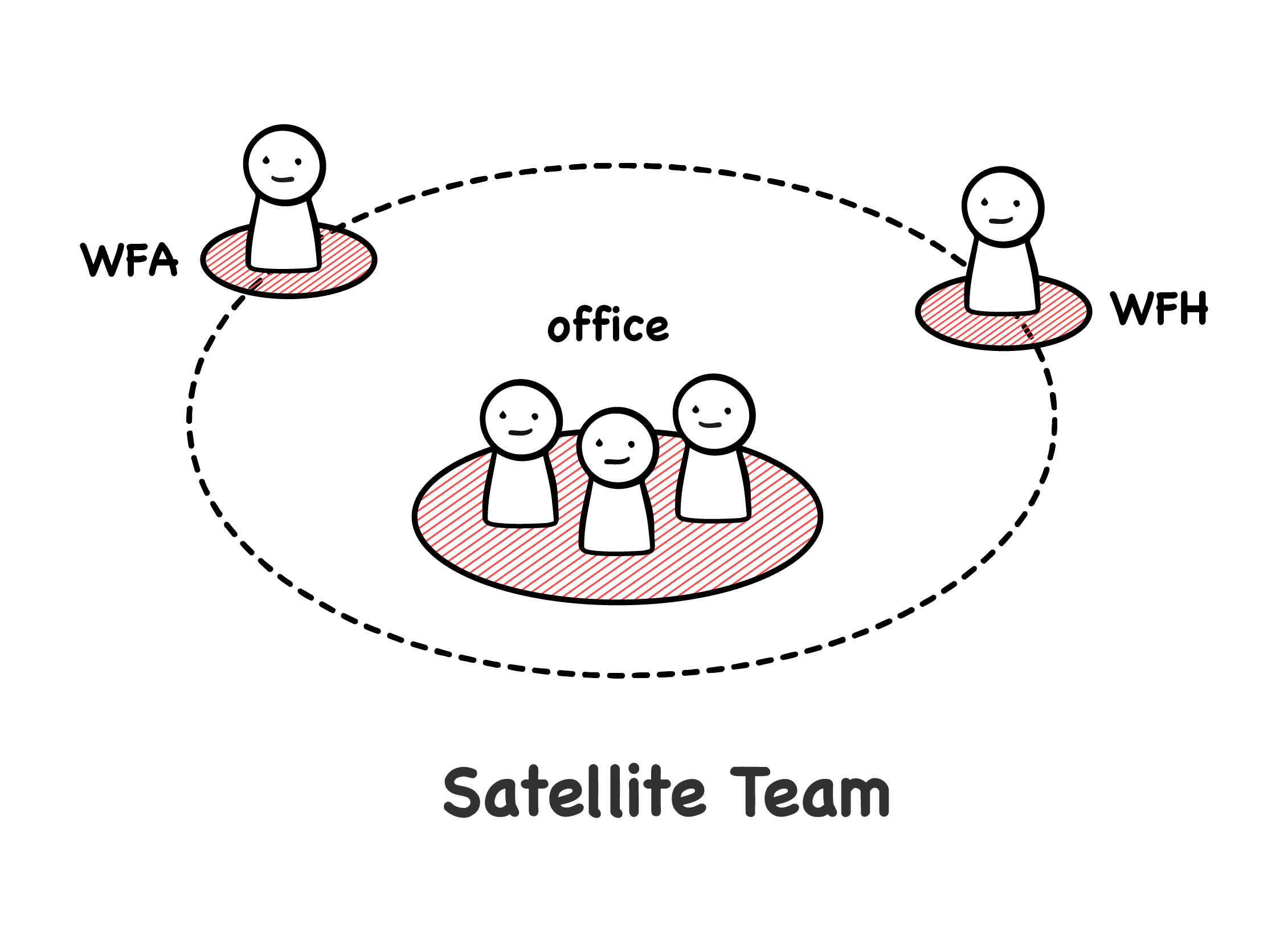
A second type of remote hybrid team forms when you have clusters of people in different locations. This typically occurs in medium to large organisations when you have functional groups (development, QA, user experience) based in different locations, or the organisation brings in a group of contractors specialising in one of these functions. Both of these scenarios are represented in the image below.
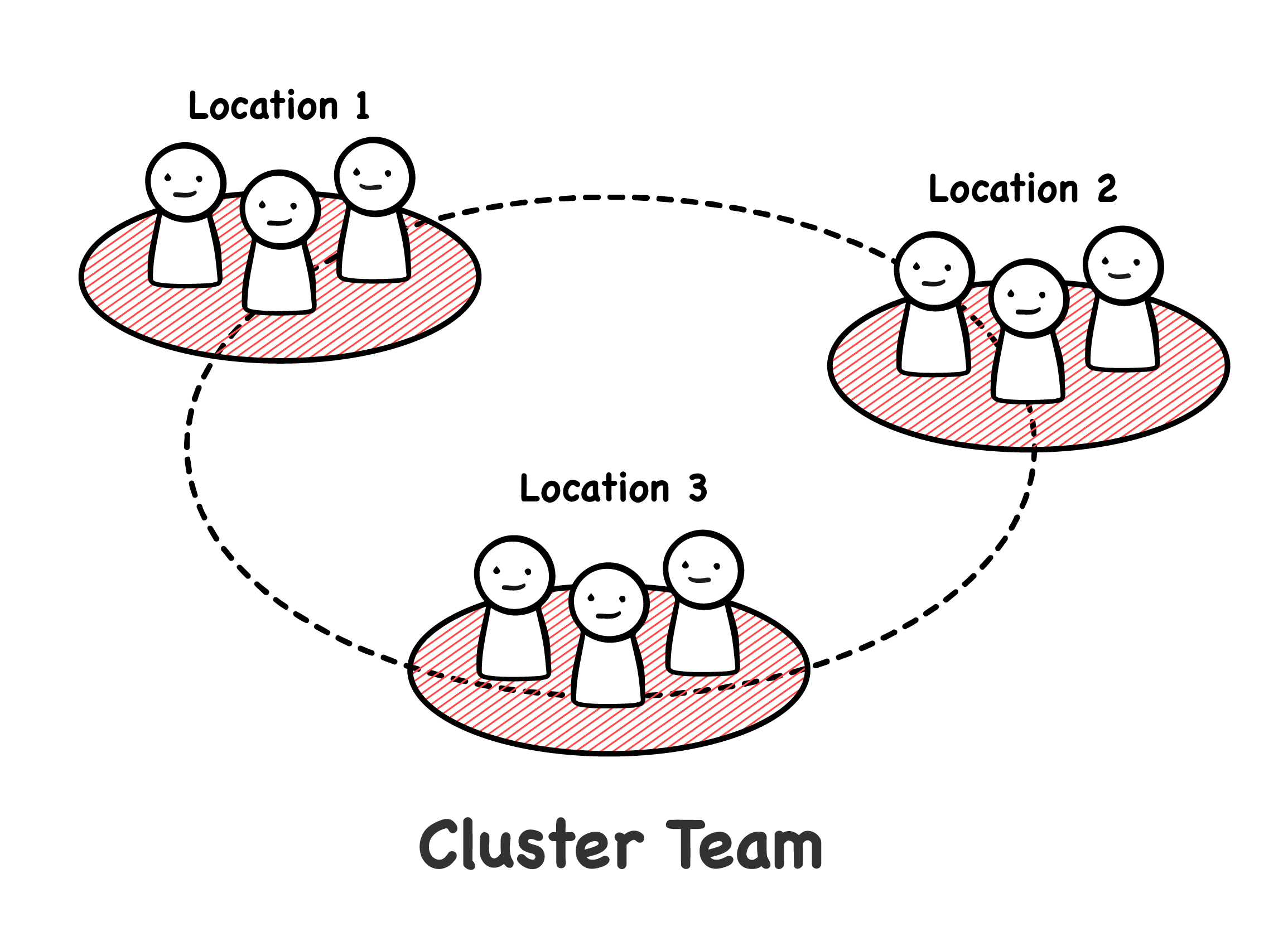
But there is a third type of hybrid remote team. In this third configuration, you have a mix of the satellite and cluster team types as shown in the image below.

Typically, this configuration is found in larger organisations where expertise is recruited from different parts of the company.
The main parts of the team are represented by clusters with some satellite team members. Some satellite team members may be connected to one cluster through prior working relationships, organisational reporting structure, or social connections. Typically, these team members work from home (WFH).
Another type of satellite team member may work with multiple clusters. They can work from anywhere (WFA) to leverage their skills for a particular cluster in the team or for the entire team. They may choose to shift their location or schedules when the team is not fully utilising their capabilities to serve other teams or other clients. Because of their extreme flexibility in schedule and location while maintaining a disciplined outcome for various parts of the team, they may also be referred to as “digital nomads”.
What makes hybrid remote work so difficult?
Before the pandemic, hybrid remote teams were challenging because most hybrid remote team members juggled two very different collaboration styles: a strong affinity style and a weak affinity style. Both are shown for satellite and cluster teams in the diagram below.
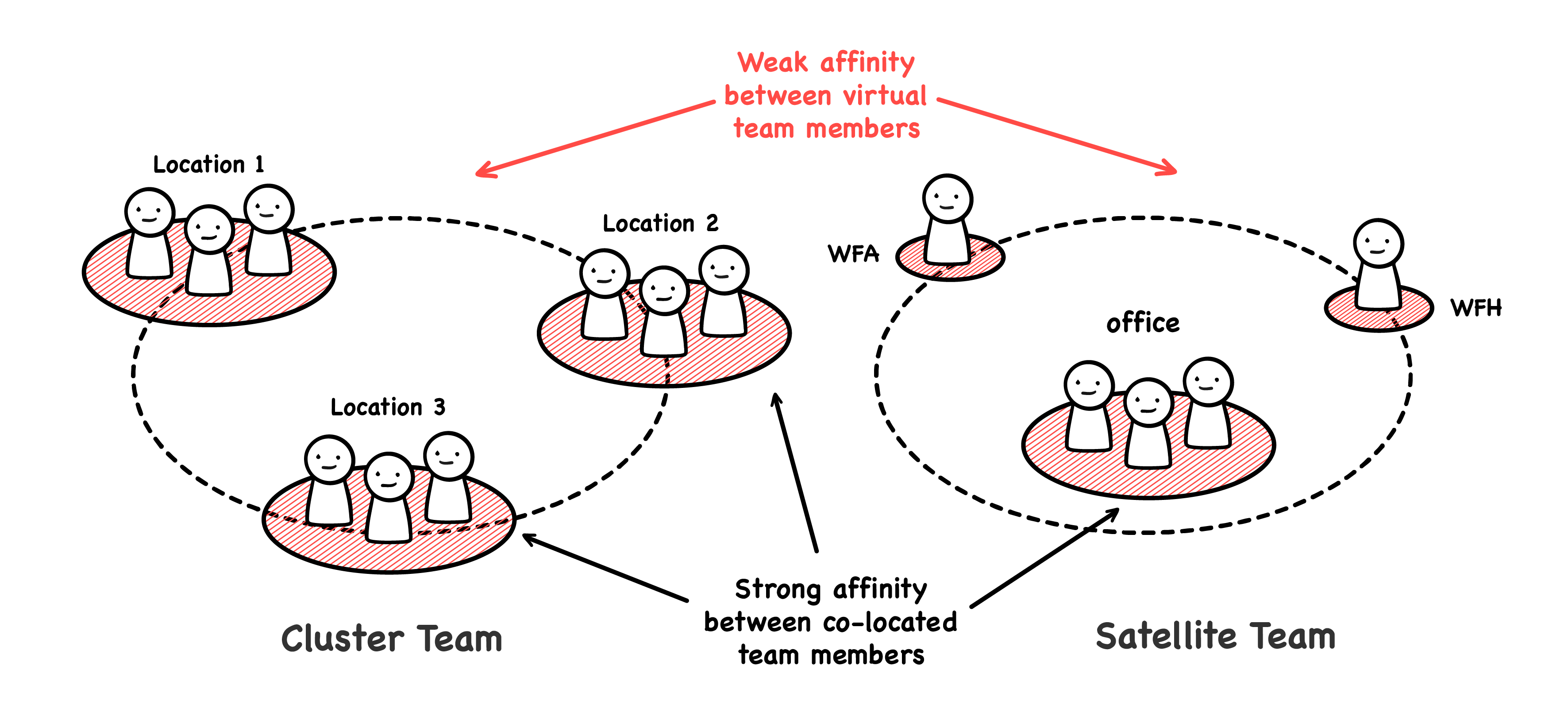
Strong affinity typically exists between co-located team members. They often see and hear each other in the same office space. This allows for more rich and natural communication, a topic which we explore more in our book. People often consider this environment more serendipitous.
Weak affinity typically arises between co-located and remote team members. The best way to think of this is with the phrase “out of sight, out of mind”. Because we don’t physically bump into these people in the hallways, we may not stay as connected with them. Team members who are co-located even forget to invite these remote team members to meetings because of this weak affinity.
However, it’s not the distance or time difference that has the greatest impact. In their April 2020 book, The Power of Virtual Distance, Drs. Karen Lojeski and Richard Reilly describe their research on virtual distance. The research spans 1400 studies from more than 55 countries and 36 organisational sectors for more than 15 years. They define virtual distance as “a felt sense of distance that grows unconsciously when we rely heavily on mediated communication through smart devices”. Since we all use smart devices these days, this leads to their main principle that “everyone is a virtual worker; therefore virtual distance impacts everyone, everywhere”.
What’s interesting about their research are the components of virtual distance and what has the greatest impact, as shown in the figure below. Physical distance, which includes geographical distance and time zones, has the least impact on the feeling of virtual distance and several tactics have been used before and during the pandemic to overcome this challenge. Operational distance provides twice the impact of virtual distance, and includes things like communications networks, online collaboration tools, the readiness of the technology infrastructure, and the ability of people to properly use this technology. The greatest impact comes from affinity distance which reflects social connections, cultural differences, and any interdependence between people for the work. Affinity distance has twice the impact of operational distance and four times the impact of physical distance.
Another way to think about these components of virtual distance would be as bridges that your team needs to cross to work together successfully as a hybrid remote team. The physical distance bridge becomes an easy crossing with flexible schedules and a combination of synchronous and asynchronous collaboration. The operational distance bridge requires more of an investment of time and money, but with a solid infrastructure and training it can also be quickly crossed. The third bridge, affinity distance, is not only a longer journey, but it’s often hard for people to even find if they’ve not been well prepared. For instance, are they prepared for cultural differences on the team, are they aware of the interdepencies they have with each other on the work, and do they have personal connections with all members on the team? How prepared team members are to navigate these differences results in weak or strong affinity that typically exists in hybrid remote teams. However, if your team and organisation are prepared, crossing the affinity distance bridge and effectively reducing that affinity distance between team members means your team can work as effectively as any co-located team.
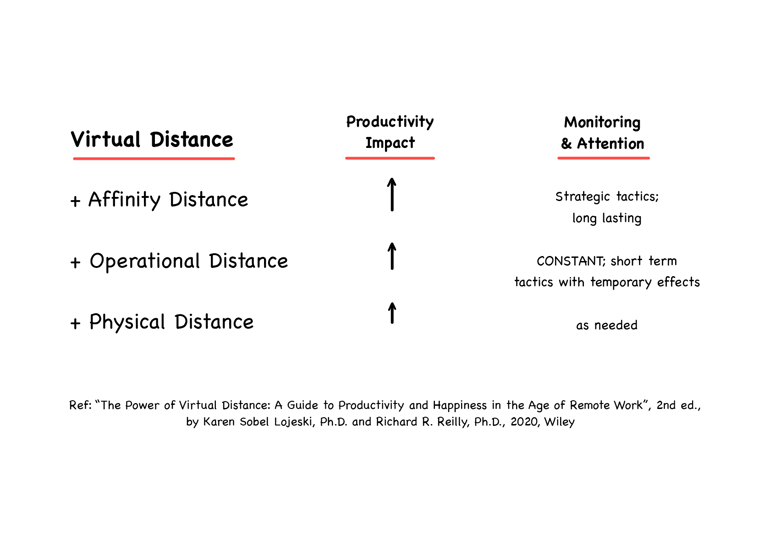
However, the pandemic forced many teams into going remote when they were not prepared. Choice is a key element of successful remote work and a lack of choice can place a team in suboptimal conditions that increase operational and affinity distance. In other words, without choice, remote or hybrid remote teams find the bridges of operational distance and affinity distance too difficult to cross.
Is hybrid remote the end or the beginning?
The remote work genie is out of the bottle. Some employees do want to go back to the office, but not every day. Why? Because they’ve discovered that remote work gives them more focus and control over how and when to work. In other words, employees discovered ways they could optimise their own work and life with remote work. Hence, choice is critical for successful remote work. To avoid a loss of talent, many companies see hybrid remote work as the next destination. With this thinking, companies will face upcoming struggles in the current rush to hybrid remote work.
Struggle 1 - Many companies will fail at hybrid remote
Many companies are declaring policies on when and where employees can work to support a hybrid remote workplace. These organisations miss the point that choice is key to successful remote work. Choosing what days employees work remotely becomes an arbitrary policy decision which can lead to more disgruntled workers.
To better understand the struggle here, it’s best to understand the type of work and the generations of workers involved. Apple often pops up in conversations these days as one of the hybrid remote examples since the first news shared about their hybrid work policy. Apple produces an ecosystem of products that rely on development of hardware and software. Does development of a complex product ecosystem require everyone to physically work in the same location?
Software, as many of us know, can itself be complex. However, it can now be created anywhere. If you are not convinced, take a look at the licences on any software you use and see what mention you find of open-source software used in the product. That open-source software was not likely developed in company offices (currently estimated to be over 90% of commercial software).
Perhaps there are other reasons to justify specific days for hybrid remote work at Apple. Hardware development would imply physical presence to develop and collaborate. However, the technology has improved greatly with emulation software and component suppliers that are world wide. So those advances would also imply that not everyone needs to be in a hardware development lab every day. With a $4 billion dollar investment in their latest office complex, Apple might have strong financial reasons for a hybrid model. However, other companies are finding creative ways to repurpose their office space (which we share later in this article).
Many of those outside of Apple are saying the choices in the Apple policy are “a bit odd”, “hybrid work should be more voluntary”, it reflects “Apple’s timid endorsement of remote work”, and “some say it’s out of step with (the flexibility) other big tech companies in Silicon Valley”. Even Forbes questions if hybrid work will be one of the biggest challenges Apple will face.
One thing is certain, we will all “think different” about remote work after this current wave of hybrid remote work experiments. Apple will once again be known for that phrase, but not in the way they hope. Other companies that are restrictive in their remote work policies may face similar public challenges.
However, one may wonder if parts of Apple are rethinking remote work already. A search of “Apple remote jobs” pulled up the following results on Google on Aug 23, 2021.
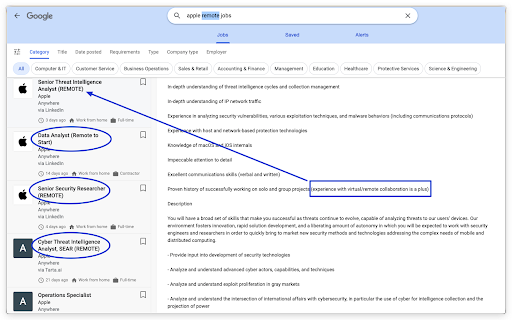
So some parts of Apple might be ready to “think different” on remote work.
Struggle 2 - The Great Resignation was just the first wave
The Great Resignation of April 2021 resulted from employees finding more options. In June 2021, 3.9 million Americans quit, very close to the 4 million in April. They had choices and they exercised those choices. If they could not find them at their current workplace, they found another.
Employees, especially in areas like silicon valley, see remote work as a new perk. Is remote work the new version of the ping pong table in the office? No. Again, it’s about choice. If employees feel they have a choice in how to optimise how they work, they feel trusted. And they are more likely to trust their employer. So raising wages will not work either. As another article recently said: “You can’t buy great employees. But you can definitely earn them.”
Turning again to the Apple example, the Verge shares how the firm might be cracking down on remote work requests. The same article indicates that hundreds may be ready to leave Apple if changes are not made to the new remote work policy. Many other companies providing more flexibility will have an advantage. Companies not providing remote work flexibility may not see departures yet, but job sites indicate that many employees are looking at remote work options.
Struggle 3 - Companies will choose again: in office or remote
Hybrid remote becomes a temporary solution. More likely, companies will either choose to go more fully remote or return to fully in-office. Another way to view this is: will companies become more employee-centric or employer-centric?
For instance, Dropbox was an office-based organisation before the pandemic but they were starting to explore what remote work would look like for their employees. When the pandemic hit, they decided to use this as an opportunity to accelerate their experimentation. They approached the employee experience as a design thinking problem. What would employees need from remote work? How might they still need to utilise office space? Dropbox decided to let employees choose to work from home when they wanted and converted their offices into collaboration studios. All individual office space would be removed. Collaboration space could be reserved by teams as needed.
Companies that cannot give their employees choice will likely grow uncomfortable with people out of the office. Once the pandemic is long past, it would not be surprising to find companies dismantling their hybrid work policies. But will they still have the best and the brightest and the most reliable workers in the office?
Build your bridges to better ways of working
Given these different types of bridges and the struggles, how can we help our teams cross into successful ways of working remotely as a hybrid remote team? Three approaches come to mind.
First, you can use a buddy system for your satellite and cluster teams. In a buddy system, you pair up one person in the office with one remote (satellite) person. Typically, this is done in meetings to ensure the remote buddy can hear and collaborate with others in the meeting. This helps team members reduce their operational distance. However, I find that people often stay connected outside meetings to collaborate this way also. When this happens, rotating who in the office “buddies” with different remote individuals can help the team reduce affinity distance. Of course, there are exceptions. From a neurodiversity viewpoint, rotating buddies may be highly disruptive to someone autistic. Again, providing choice to teams makes a significant difference in their success. There is no one policy that fits all situations.
Related to the buddy system is the copilot system, with the copilots acting as co-facilitators of several interactions across the team. The copilot system tends to work well with cluster teams and consists of a copilot in each location who coordinates with copilots in other locations. In meetings, the copilots help read the body language and mood of the people in the room and let the other copilots know how they might want to slow down the meeting for questions or speed things up if it looks like all is going well. Also, I find the copilot relationship works well outside of meetings to gauge the mood of different parts of the team and to be more aware of cultural differences. So like the buddy system, the copilot system can help a team bridge the operational and affinity distance.
Another way to increase affinity across the team is to ask team members to change their location at different times. For satellite teams, this means those typically in the office might work remote at times to better empathise with their always remote colleagues. Remote colleagues should spend some time in the office to gauge what else pulls at the attention of their in-office colleagues. For cluster teams, you might occasionally ask for people to visit other locations (clusters) to see how their cluster responds and to better empathise with others on the team.
Asking people to pair up or rotate to build empathy and support communication can help build those bridges to shorten overall virtual distance. It may even change how some team members feel about office work or remote work and encourage other bridges to be built for exploring better ways to work together.



 Previous article
Previous article
